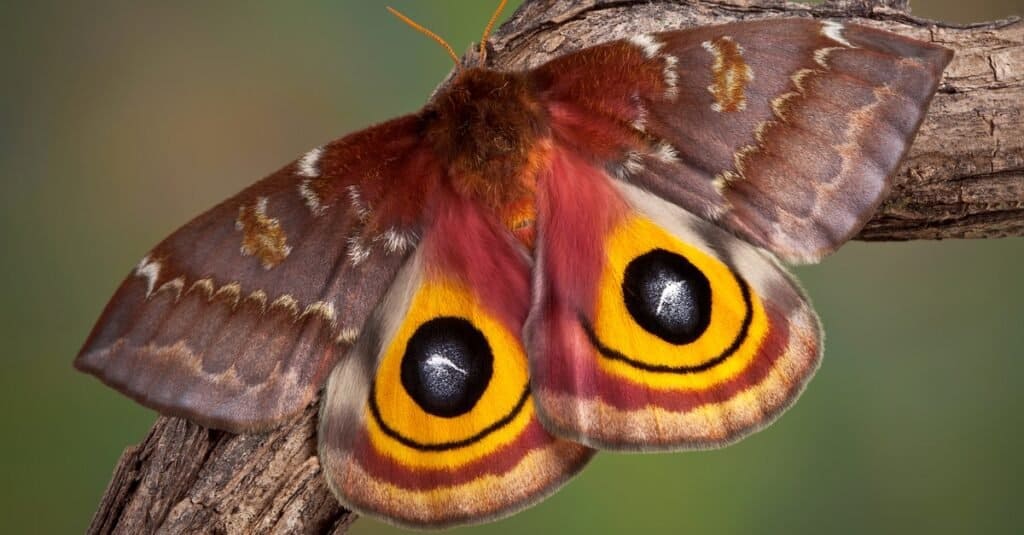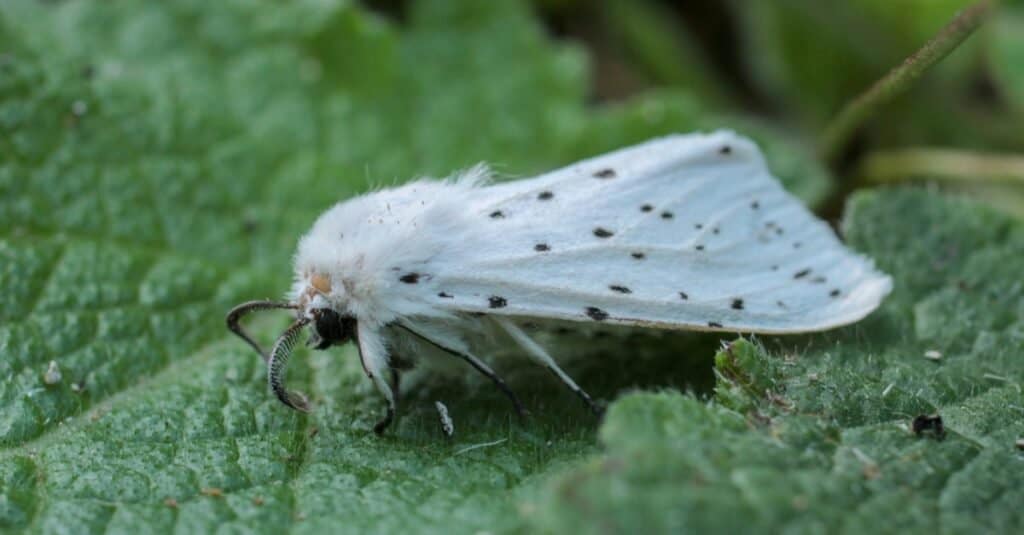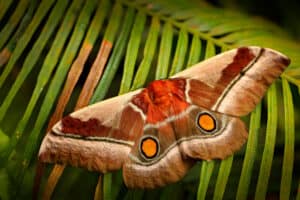Attracted to light and prone to eating the clothes in our closet, moths live unique and interesting lives. But how long do moths live, on average? And what are their lives like, no matter how long or short they happen to be?
In this article, we will discuss a moth life cycle as well as why moths happen to live as long as they do. We will also discuss why certain species of moths live longer than others, and how their overall lifespan compares to that of butterflies.
Let’s learn more about these winged insects now.

Attracted to light and prone to eating the clothes in our closet, moths live unique and interesting lives.
©Cathy Keifer/Shutterstock.com
How Long Do Moths Live?
Moths live an average of 1-6 months, depending on the species of moth. For example, the common brown house moth can live as long as four months, but silkworm moths only live a week or two.
This is a surprisingly large range, and the lifespan of many moths depends on their individual genetic makeup as well. For example, many species of moths are born without mouths, living solely on the energy stored in their bodies from the pupating process.
The idea that some moths only make their transformation in order to continue their species and then die is a common theme among the many different moth varieties. This is both an interesting fact and a foreign concept to us as human beings.
What else about a moth’s life might be interesting to us? Let’s continue to learn about them now.

©RECEP_OZTURK/Shutterstock.com
The Average Moth Life Cycle
Similarly to caterpillars, moths have an intricate life cycle in need of studying. No matter the species, all moths go through a variety of transformations. Let’s discuss those in detail.
Egg
Depending on the species, a female moth can lay over 50 eggs during a two-week period of time, and some can lay hundreds, depending. Many female moths die after laying eggs, as this appears to be part of their genetic makeup.
The eggs are left unprotected for a little over a week on average, depending on the species of moth. During this time, the baby moths or caterpillar will receive nutrients and necessary sustenance from the egg it is encased in.

Depending on the species, a female moth can lay over 50 eggs during a two-week period of time.
©Kevin Collison/Shutterstock.com
Larvae and Pupae
Moth larvae or caterpillars will emerge from their eggs after a 7 to 14 day period of time. Like many other species of bug, moth caterpillars will consume the eggs that they hatched from, as this includes valuable nutrients and growth supplements.
Moth caterpillars are capable of transforming multiple times during this stage, and go through molting processes called instars. After every transformation and growth, the larvae will eat their previous shells, as they have necessary nutrients much like their eggs did.
Depending on the species of moth, it will go through any number of instars before it is ready to pupate. The caterpillar will find a secluded place to build its cocoon, and perform one final shedding of its skin before hiding away for any number of days.

Depending on the species of moth, it will go through any number of instars before it is ready to pupate.
©Andreas Weitzmann/Shutterstock.com
Grown Moths
Many different moth species emerge from their cocoon after at least 10 days, if not closer to a month. Their incubation time depends on the weather and climate they are currently cocooned in, as well as their species.
No matter how long it takes, the pupation stage matters the most. Moths cannot become the winged insects that they are without it. Plus, a moth doesn’t emerge from its cocoon completely ready and able to fly. It needs a few hours to dry out and rest, as it adapts to its new body.
This is often when the average moth lifespan gets cut short. Freshly hatched moths are entirely vulnerable during this moment, waiting for their wings to dry out. They are incapable of escaping, and many predators may be lying in wait.
This portion of their life sounds strikingly similar to another famous insect. Butterflies go through a similar life cycle, but does this mean that their life spans are similar? Let’s learn more about these two bugs and their differences now.
How Does Their Lifespan Compare to Butterflies?

The Luna moth has an average lifespan of no more than one week.
©Ryan Hughes/Shutterstock.com
Butterflies have a very similar life cycle to the moth. They hatch from their eggs, go through multiple instars as they outgrow their caterpillar form, and eventually form cocoons. After they emerge from their cocoon, they must dry out their wings for a few hours. This makes them identical to moths in just about every way.
However, depending on the species of butterfly, most butterflies only live an average of a week to a month. Moths seem to have a longer life span in some respects, but it all comes down to the species and what they go through.
For example, the monarch butterfly is a unique butterfly in that it either lives a few weeks or almost a year, depending on when it was born. Monarch butterflies who are born toward the end of summertime have the ability to hibernate, therefore making their adult lifespan months longer than their generational counterparts.
Moths also usually have a shorter lifespan due to the fact that their females often die after laying their eggs. This is not always the case for butterflies, though some species follow this similar process. However, it is an occurrence that happens to the majority of female moths, therefore limiting their lifespan.
No matter the case, both of these insects go through remarkable transformations and merge as beautiful winged creatures capable of flying hundreds of miles, depending on the species. Both moths and butterflies are fantastic to observe and fascinating to study, so I hope you have enjoyed your time.
The photo featured at the top of this post is © Cathy Keifer/Shutterstock.com
Thank you for reading! Have some feedback for us? Contact the AZ Animals editorial team.






